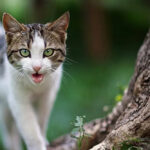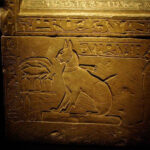The notion of a Cat Rabbit Hybrid, often playfully termed a “cabbit” or “rabcat,” has captivated imaginations and sparked debate for generations. While the concept might seem like folklore, tales and purported sightings persist, painting a picture of a creature that blurs the lines between feline and lagomorph. Is there any truth to these claims, or are cabbits merely a product of wishful thinking and misidentification?
Despite the lack of definitive scientific confirmation, the idea of a cat rabbit hybrid is surprisingly well-documented, arguably more so than some other seemingly more plausible interspecies crosses, such as the often-debunked cat-dog or cat-raccoon hybrids. The internet is rife with videos claiming to depict cabbits, and countless eyewitness accounts further fuel the mystery.
One compelling piece of anecdotal evidence comes from Tucuman, Argentina, where an animal has been observed that strongly resembles a cat rabbit hybrid. Videos circulating online showcase this Tucuman creature, exhibiting a distinctly feline front half seamlessly merging into a rabbit-like rear. Adding to the intrigue, its locomotion is described as rabbit-like hopping, further distinguishing it from typical feline movement.
Article continues below
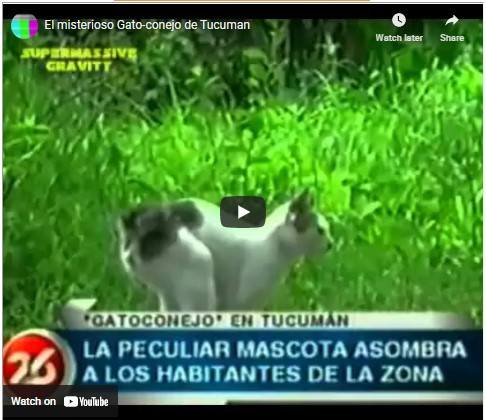 Animal resembling a cat rabbit hybrid in Tucuman, Argentina
Animal resembling a cat rabbit hybrid in Tucuman, Argentina
Explore more videos of alleged cabbits >>
Read firsthand accounts describing cabbits >>
The Question of Cabbit Existence: Fact or Fiction?
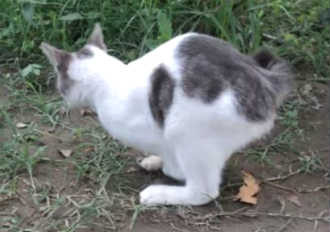 Close-up of the Tucuman animal highlighting plantigrade hind feet
Close-up of the Tucuman animal highlighting plantigrade hind feet
Image of the Tucuman animal, showcasing the plantigrade position of its hind feet, a rabbit-like trait.
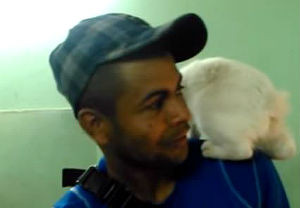 Screenshot from a cabbit video emphasizing rabbit-like features
Screenshot from a cabbit video emphasizing rabbit-like features
A still from a video compilation of cabbit sightings, drawing attention to the animal’s rabbit-like posterior. Watch the video to see more >>
Unsurprisingly, the concept of cat rabbit hybrids has met with considerable skepticism and even ridicule. Nineteenth-century naturalist Francis Trevelyan Buckland, for instance, dismissed such claims, suggesting that purported cabbits were simply “Manx cats with birth defects.” In a humorous anecdote, Buckland (1882, p. 33) recounted a conversation with Abraham Dee Bartlett, then Superintendent of the London Zoo, stating, “To Mr. [Abraham Dee] Bartlett [then Superintendent of the London Zoo], are brought sometimes supposed hybrids between a cat and a rabbit. Our friend says a cat with a short tail will not prove the argument. He wants a rabbit with a long tail.” This highlights the historical skepticism surrounding the cat rabbit hybrid phenomenon.
Conversely, passionate proponents of cabbit existence vehemently assert their reality. Sarah Hartwell, who authored an article arguing against the possibility of cabbits, shared an email she received from a staunch believer: “I just read your article on your web page and have to tell you that you are full of crap. Cabbits are real, I have had them and bred them and they are abundant in Ontario. No one has become famous, as you say about some vets in your article. It isn’t rocket science and no one will be getting a Nobel for it. They are an accepted species in Ontario. I have pictures and can describe anything you want to know about them. They have soft fur like the rabbit, look like a cat except they have the hind legs of the rabbit, they are silent, don’t meow and they kind of hop/walk. It is possible for some species to cross-breed, it just isn’t much thought of. You really should research before you go spouting off. What the hell are your qualifications anyways?? I and my parents before me have been registered breeders of the CKC [i.e., Canadian Kennel Club]. I can also tell you that I can tell when 2 animals are mating and when 8 weeks later babies are born and the only 2 “going at it” was the rabbit and the cat. They are not manx and you really should have a few certificates on your wall before you judge those of us who actually know what we are talking about.” This fervent testimony underscores the deeply held beliefs surrounding cat rabbit hybrids in certain communities.
Article continues below
 Frontal view of a cabbit-like animal
Frontal view of a cabbit-like animal
A front-facing view of the same animal featured at the beginning of this article, further emphasizing its unusual morphology.
The debate surrounding cat rabbit hybrids often descends into accusations of ignorance or dishonesty on both sides. Initially, even those researching animal hybrids were dismissive of the idea due to the significant evolutionary distance between cats and rabbits. However, the sheer volume of video evidence surfacing on platforms like YouTube, showcasing animals that strongly resemble cabbits (many of which can be viewed here), has prompted a reconsideration of this stance. Genetic testing is the definitive way to resolve this question, yet no laboratory with the necessary resources has undertaken such an analysis.
It is a documented fact that male rabbits (bucks) have been observed attempting to mate with female cats. Numerous videos on YouTube corroborate this interspecies mating behavior. Furthermore, a dedicated page on this website compiles videos of purported cabbits, all exhibiting feline front portions and rabbit-like hindquarters, coupled with rabbit-like hopping locomotion. Are these simply Manx cats with deformities, or could they genuinely be cat rabbit hybrids? The available evidence strongly suggests that this intriguing possibility warrants further scientific investigation. If these animals are indeed hybrids, DNA analysis would readily confirm their hybrid status, particularly if they are first-generation (F₁) hybrids. Identifying later-generation backcross hybrids through DNA analysis presents a greater challenge.
Interestingly, there are documented instances of cats nursing and raising rabbits. The phenomenon of imprinting, where animals raised by a different species may later prefer mating with that species, is well-established. This could theoretically lead to hybridization. The following video captures a cat nurturing a litter of rabbits:
Article continues below
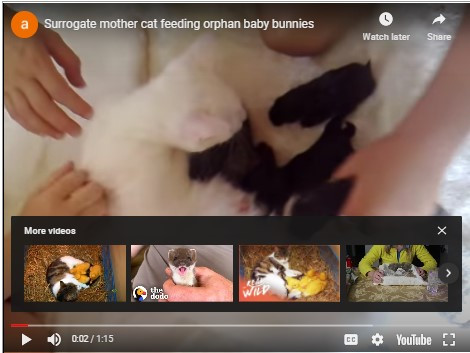 Cat nursing rabbits, a possible imprinting scenario
Cat nursing rabbits, a possible imprinting scenario
Rabbits raised in such interspecies nursing scenarios could potentially imprint on cats, leading them to seek out feline mates upon reaching sexual maturity, a prerequisite for cat rabbit hybrid offspring – assuming such hybrids are biologically possible.
Considering the Manx cat breed, if their origins are indeed hybrid (as explored in the section on Manx origins here), the rabbit parent would likely be the European rabbit (Oryctolagus cuniculus), the only rabbit species native to the Isle of Man. Regarding the various alleged cabbits depicted in online videos, the specific rabbit species involved remains uncertain. However, the European rabbit, a highly adaptable and invasive species, has been introduced to numerous regions globally, and various breeds closely related to it are popular domestic pets, increasing the potential for interaction with domestic cats.
Common Arguments Against the Possibility of Cat Rabbit Hybrids
From the Lubbock Evening Journal – Lubbock, Texas – May 27, 1953:
CABBIT—Mrs. Norm Weiler of St. Petersburg, Fla., has a new pet, but she’s not sure what it is. The animal has the head and shoulders of a cat, and the body of a rabbit, while its voice is half growl, half meow. Mrs. Weiler, who adopted the creature when it wandered into her yard recently, calls her new pet “Cabbit.” She says it hates fish, loves cabbage and roast veal.
(This news snippet, typical of cabbit reports, was accompanied by a photograph of a purported cat rabbit hybrid.)
Chromosome Number: A primary argument against the possibility of cat rabbit hybrids centers on the difference in chromosome numbers between cats (2n=38) and rabbits (2n=44). It is often asserted that this chromosomal disparity renders hybridization impossible. However, this claim is contradicted by documented instances of successful hybridization in mammals with even greater differences in chromosome numbers. This website provides numerous examples of such interspecies crosses. For instance:
Sheep and goats, whose chromosome numbers differ by six, precisely the same difference as between cats and rabbits, are known to occasionally produce hybrids.
A lighthearted perspective:
A Twitter follower’s question: “But do cabbits eat carrots or fish?”
Response: “Most enjoy a nice mouse and tuna casserole with plenty of lettuce and carrots, and perhaps a light, re-ingestible pellet topping.”
(On a more serious note, observing the video footage linked at the top of the cabbit videos page reveals one of the creatures consuming a carrot and an avocado.)
Gestation Period: Another frequently cited argument is the difference in gestation periods between cats (approximately 64 days) and rabbits (around 31 days). The longer feline gestation period is often presented as an insurmountable barrier to hybridization. This argument, however, is an age-old notion, dating back to at least the time of Pliny the Elder in the 1st century A.D. Counterexamples, such as the well-established cama (dromedary camel gestation: 13 months, llama gestation: 11 months) and wolphin (false killer whale gestation: 15.5 months, bottlenose dolphin gestation: 11.5 months), invalidate this argument. Both of these hybrids are documented on this website (camas and wolphins). In the case of the wolphin, the gestation periods differ by a significant four months, far exceeding the one-month difference between cats and rabbits. Furthermore, domestic pigs (gestation: 115 days) and babirusas (gestation: 150-157 days), with a gestation period difference of approximately 33%, also produce hybrids. Thus, the gestation period argument against cat rabbit hybrids appears to be an unfounded myth.
| Cabbit Humor— by Chris Millar Buck rabbit cat Rabbit bucks cat Buck Rogers cat |
|---|
Genetic Distance: A third argument posits that cats and rabbits are too genetically dissimilar to produce viable offspring. While genetic divergence is a factor in hybridization, the precise threshold at which it becomes an absolute barrier is unknown. Moreover, the specific nature of genetic differences that prevent hybridization remains poorly understood, even to those with expertise in genetics and hybridization research.
Anatomical and Evolutionary Differences: Similar to genetic distance, the argument is made that anatomical and evolutionary differences between cats and rabbits preclude hybridization. However, hybridizing species often exhibit significant anatomical variations, and the limits of anatomical divergence in successful hybridization are not defined. Likewise, the degree of evolutionary relatedness required for hybridization remains unclear. The cat rabbit hybrid case itself might offer insights into these limits.
 A speculative image of a cat-rabbit hybrid
A speculative image of a cat-rabbit hybrid
Fertility and the Manx Cat: In the context of cat rabbit hybrids, the fertility of Manx cats is sometimes invoked as a counter-argument. Since Manx cats are a recognized breed capable of reproduction, and hybrids are often assumed to be sterile, it is argued that Manx cats cannot be cat rabbit hybrids. However, this argument rests on false premises. Many documented hybrid crosses, detailed elsewhere on this website, produce fertile or at least partially fertile offspring. Furthermore, numerous fertile domestic breeds are known to have originated from hybridization events. Therefore, the fertility of Manx cats does not preclude the possibility of their cat rabbit hybrid ancestry.
The “Manx Gene” and Hybrid Inviability: Intriguingly, Manx cats are not as reproductively robust as typical domestic cats. They exhibit a higher incidence of offspring inviability, a characteristic often associated with hybrids. This increased inviability is attributed to the hypothetical “Manx gene.” However, despite the prevalence of this explanation, no formal scientific study has identified, characterized, or even mapped this “Manx gene” to a specific chromosome.
Article continues below
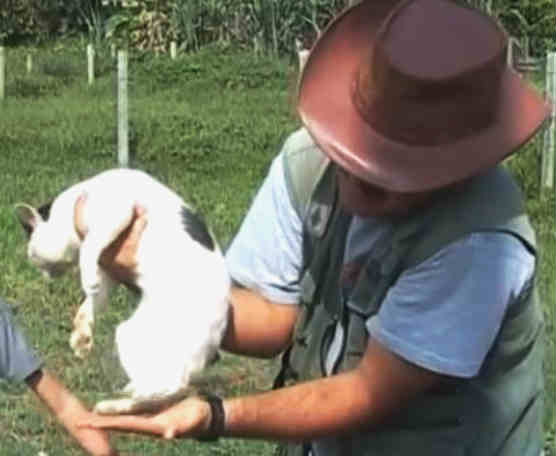 Another perspective of a cabbit-like animal from video footage
Another perspective of a cabbit-like animal from video footage
A different angle of an alleged cabbit, extracted from online video footage. (Watch the video here).
A Gametic Conundrum— by Gene McCarthy
Two gametes meet, a hopeful sign,
Their chromosomes in new design.
But outcomes, still, we can’t define,
Before the hybrid’s form align.
It is noteworthy that mating two tailless Manx cats results in a higher rate of offspring mortality compared to mating a tailless Manx with a tailed Manx (Deforest and Basrur 1979). Deforest and Basrur (1979) linked conditions like “spina bifida, urinary and fecal incontinence, and locomotor issues in the pelvic limbs” to the tailless condition in Manx cats. An alternative interpretation is that tailless Manx cats represent first-generation (F₁) cat rabbit hybrids, while tailed Manx cats are backcrosses to purebred cats. In many hybrid crosses, mating F₁ hybrids with backcross hybrids increases offspring viability compared to F₁-F₁ pairings.
Conclusion: A Puzzle Worth Unraveling
One could certainly argue that Manx cats are simply the result of a genetic mutation unrelated to rabbits, and their rabbit-like traits are purely coincidental. However, this explanation requires a series of unlikely assumptions: that a mutation (or mutations) coincidentally caused the Manx cat’s posterior to resemble a rabbit’s, including the short tail, hopping legs, and blunt claws; that mutation is responsible for Manx cats’ reported preference for rabbit-like foods like carrots and lettuce; and that the health issues associated with Manx cats are merely coincidental side effects of these unidentified mutations. Furthermore, it necessitates believing that selective breeding could, through random genetic changes, produce hindquarters in a cat that are virtually indistinguishable from those of a rabbit.
Is it not a more parsimonious explanation to consider that Manx cats exhibit rabbit-like characteristics, reduced fertility, higher rates of inviable offspring, and hybrid-associated dysfunctions because they are, in fact, cat rabbit hybrids? As Samuel Johnson famously stated, “The solution as I have given it, is plain. Suppose, I know a man is so lame that he is absolutely incapable to move himself, and I find him in a different room from that in which I left him; shall I puzzle myself with idle conjectures, that, perhaps, his nerves have by some unknown change all at once become effective? No, Sir; it is clear how he got into a different room: he was carried.”
This exploration of cat rabbit hybrids is based on a chapter from the book Telenothians, available for purchase here.
Explore more cabbit videos >>
Read firsthand accounts describing cabbits >>
Reported Cat Hybrid Crosses: A Spectrum of Possibilities
The following list details reported cat hybrid crosses, ranging from well-documented to highly improbable. The reliability of each cross varies (indicated by the reliability arrow in the original article, omitted here as per instructions). Some entries may seem entirely fantastical, yet all have been reported at least once. The links below lead to dedicated articles exploring each specific hybrid claim. Additional reported crosses, not listed here, are discussed on the cat hybrids page.
Sheep-pig hybrids?
Cat × Wildcat >>
Lion × Tiger >>
Jaguar × Lion >>
Leopard × Lion >>
Jaguar × Leopard >>
Cat × Pallas’s Cat >>
Cat × Rabbit (Cabbits) >>
Cat × Marten >>
Leopard × Tiger >>
Cat × Dog >>
Cat × Raccoon >>
Cat × Possum>>
Cat × Chicken >>
Cat × Kangaroo>>
Puma × Bear >>
Puma × Dog >>
Cat × Duck >>
Cat × Human >>
Cat × Rat >>
Cat × Opossum >>
Cat × Squirrel >>
Cat × Horse >>
| Most shared on Macroevolution.net: Human Origins: Are we hybrids? On the Origins of New Forms of Life Mammalian Hybrids Cat-rabbit Hybrids: Fact or fiction? Famous Biologists Dog-cow Hybrids Georges Cuvier: A Biography Prothero: A Rebuttal Branches of Biology Dog-fox Hybrids |
|---|
Cat-rabbit Hybrids – © Macroevolution.net

